Velvety blue. Liquid blue. Evening-sky blue. Cornflower blue. Sapphire has been coveted for centuries and romanticized through these and other terms which celebrate the rich hue of the ultimate blue gemstone, similar to this sapphire I saw at a recent American Gem Trade Association (AGTA) GemFair trade show.
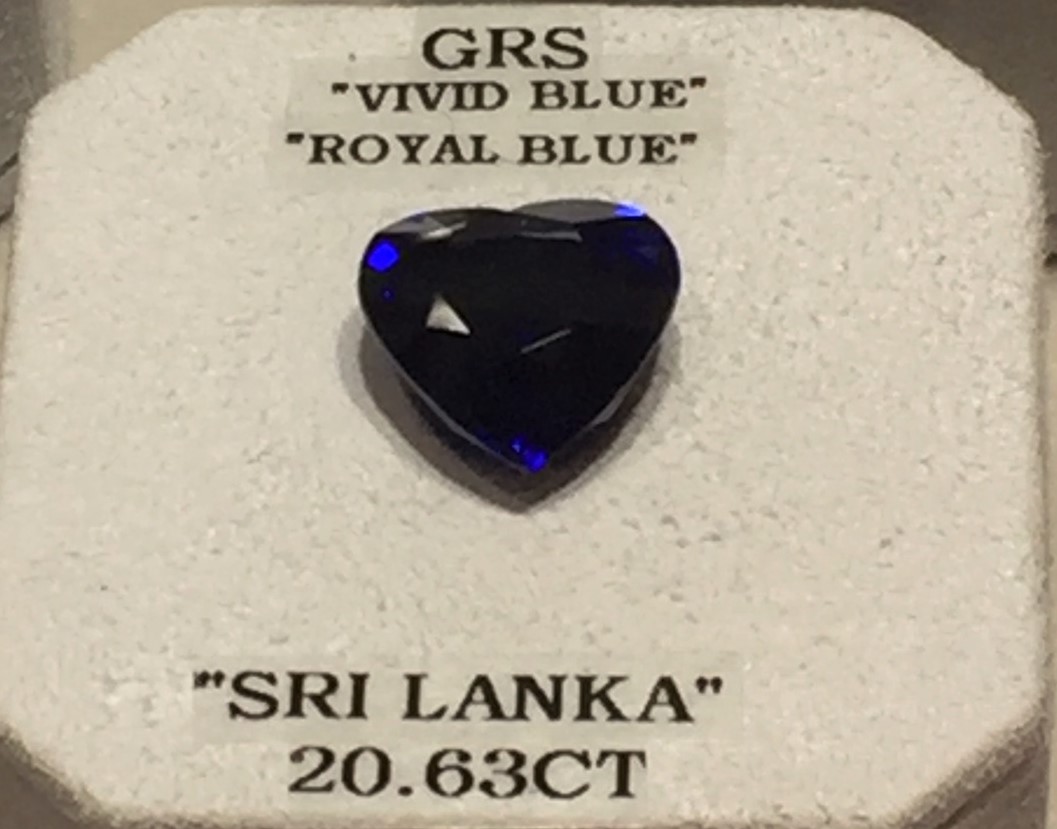
In folklore, history, art, and consumer awareness, sapphire has always been associated with the color blue. Its extraordinary color is the standard against which other blue gems—from topaz to tanzanite—are measured. The very name sapphire comes from the Greek word ‘sappheiros.’ In Latin, "sapphiru," means blue.
Despite sapphire’s inseparable relationship with the color blue, it also is available in a rainbow of colors, as seen in this sapphire suite I came across at another AGTA trade show.
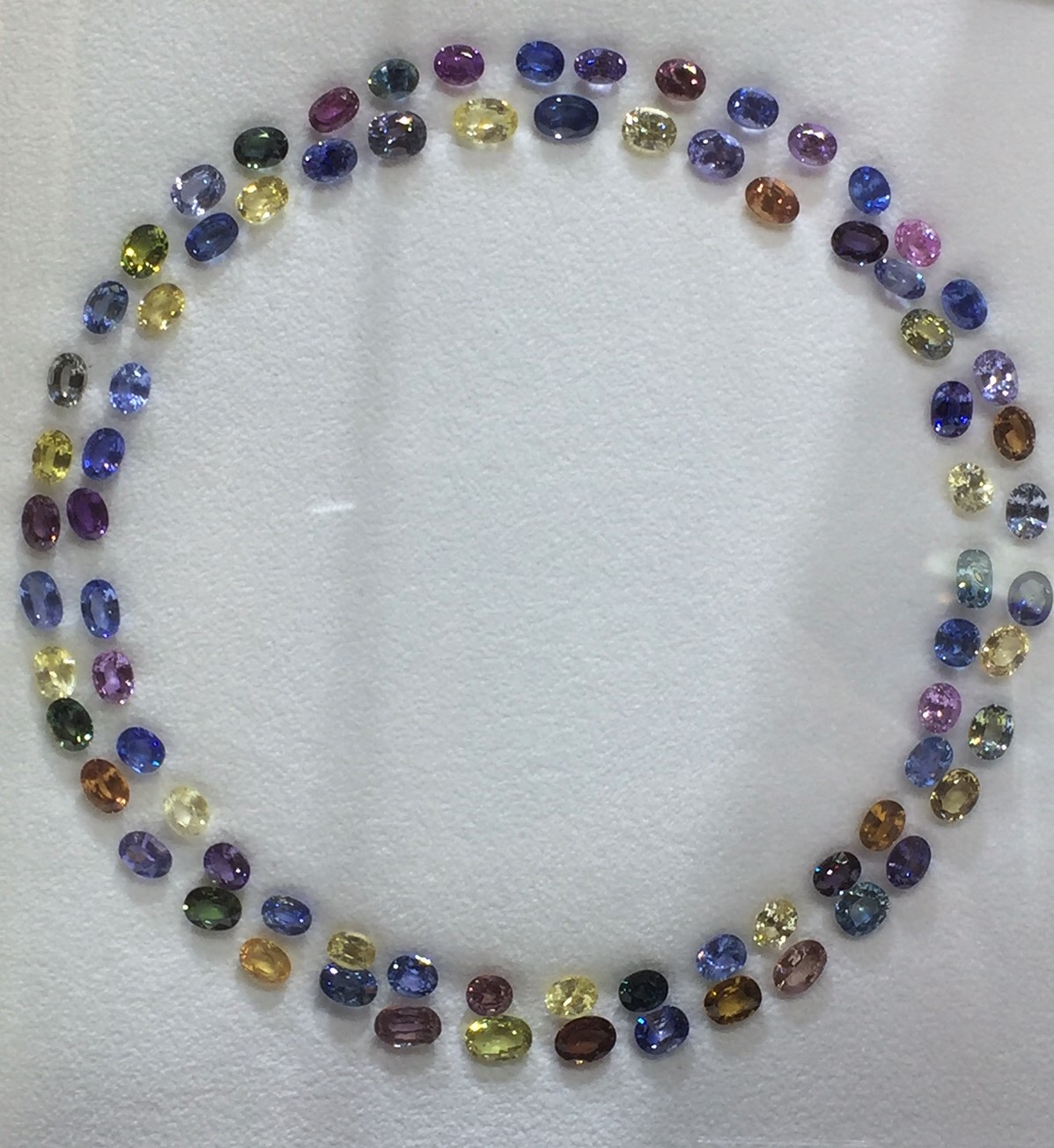
Sapphire is the gem-quality variety of the rock-forming aluminum oxide mineral species, corundum. In fact, corundum is an exceptionally hard and tough material. It’s the third-hardest mineral on earth, exceeded only by diamond and moissanite. Most people have never heard of the mineral corundum. When mixed with magnetite, it commonly creates an abrasive called emery. While many people may never have heard of corundum, they are familiar with corundum’s famous gem-quality varieties:
- Sapphire – when gem and jewelry professionals use the word “sapphire” alone, they normally mean the blue variety. Most jewelry customers erroneously think all sapphires are blue.
- Ruby is the red variety of corundum and sibling stone to sapphire. Ruby has a very prominent place in history, as well as within the current gem and jewelry industry. You can learn more about ruby by reading my blog about this special gemstone; July Birthstone: Ruby - facts and lore.
- Fancy Sapphires - any other color variety of corundum besides blue and red are known as “fancy sapphires”. Like the endless colors that appear in the sky, sapphire is also found in nearly every shade, from the gold of sunrise to the fleeting violet of twilight. Sapphire may even resemble the pale white gloom of an overcast day. Depending on the trace element contained within its crystal structure, fancy sapphire varieties can be found in violet, green, yellow, orange, pink, purple, and many intermediate hues. Sapphires can even be gray, black, or brown. Frequently, when talking about a specific fancy sapphire, the name sapphire is preceded by the color name, such as green sapphire, pink sapphire, orange sapphire, padparadscha sapphire (a mixture of orange and pink colors), etc. Padparadscha is Sinhalese (Sri Lankan language) for lotus flower, whose color this unique sapphire resembles. Sri Lankans have a special affection for this sapphire that’s traditionally been linked with their country.
- Some stones exhibit the phenomenon known as color change, most often going from blue in daylight or fluorescent lighting to purple under incandescent light.
Click the link to browse the current 100 East Fine Jewelry Sapphire Collection. Some of our recent designs include these outstanding sapphire pieces (no color qualifier means it’s the blue stuff):
Sapphire Jewelry
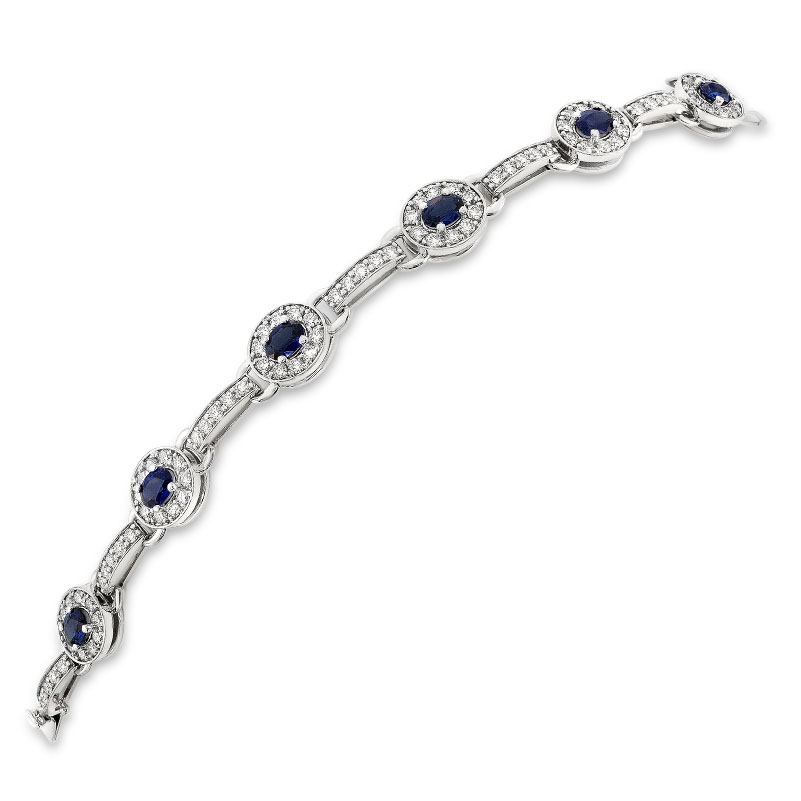
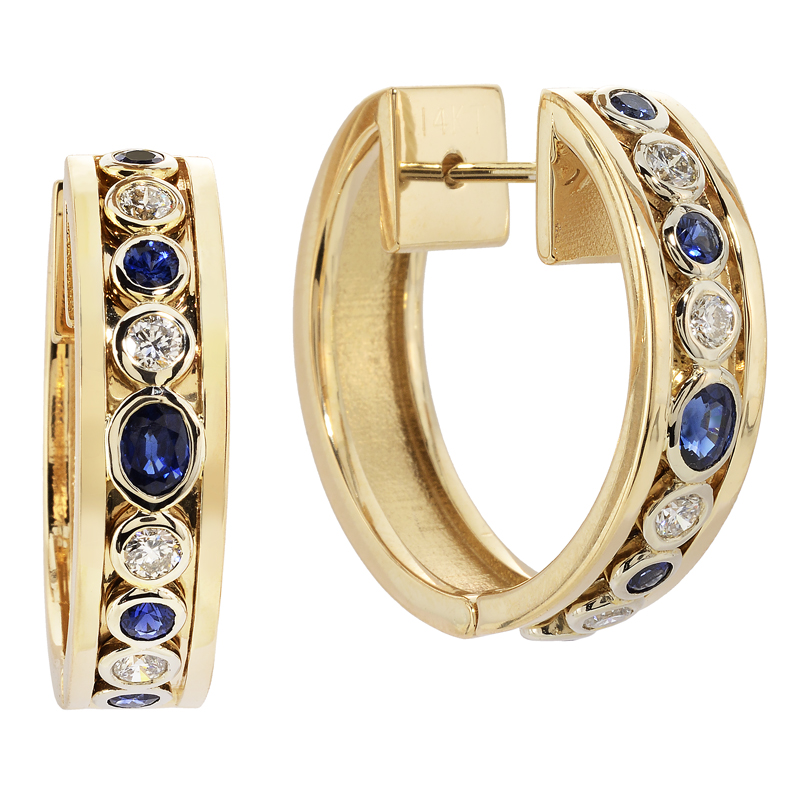
We also designed some fancy sapphire jewelry items you might find interesting (fancy means the sapphires aren't blue)!
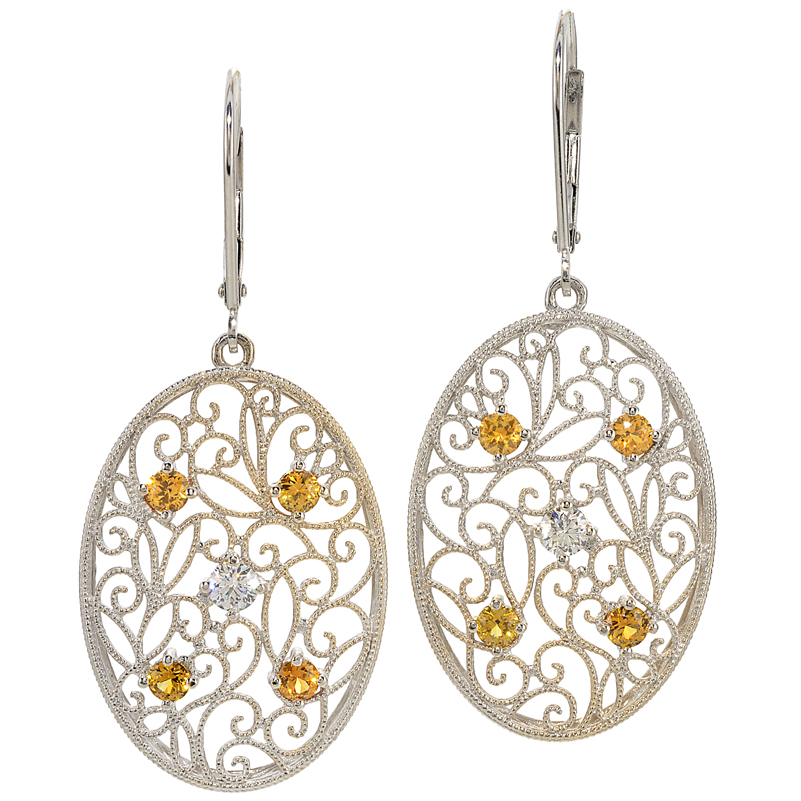
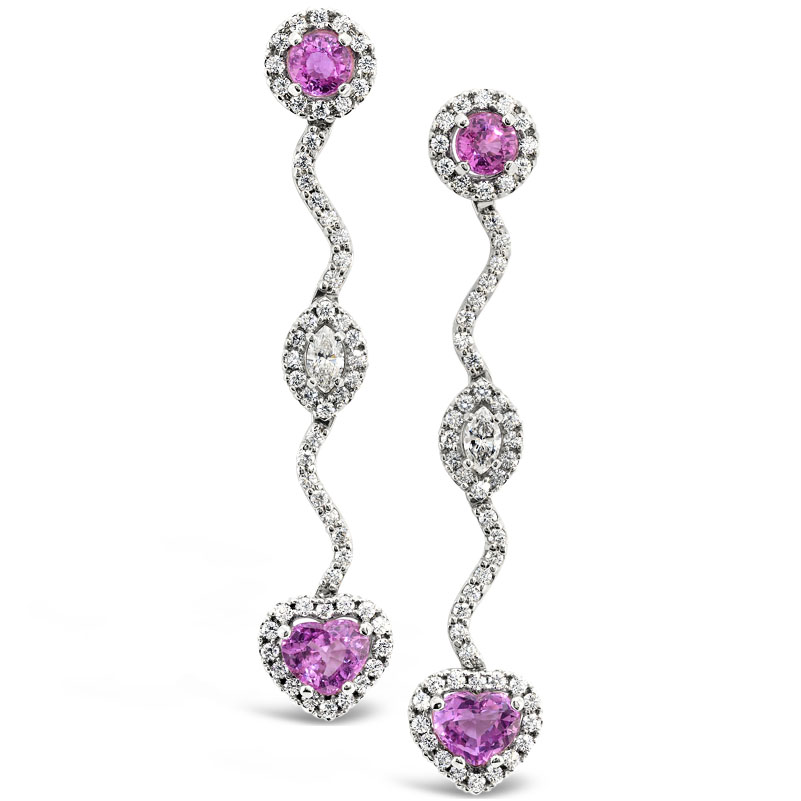
Fancy Colored Sapphire Jewelry
Designated as September’s birthstone, sapphire captures jewelry buyers’ imaginations with its aura of romance. It’s also the gemstone of the 5th and 45th wedding anniversaries.
History and Lore
Sapphire has been prized by many cultures for millennia. Sri Lanka (formerly known as Ceylon) has been a source of sapphire for more than 2000 years. Along with Myanmar (formerly known as Burma) and Thailand, these three countries are the oldest known sources of sapphire. While sapphires have been discovered all over the world, many of the most important stones came from Sri Lanka. Both blue and fancy-colored sapphires mined from the alluvial gravels of this “jewel box of the Indian Ocean” can display remarkable brilliance and saturation.
Kashmir (the northernmost region of the Indian subcontinent), Myanmar (Burma) and Sri Lanka (Ceylon) are recognized as the sources which defined the epitome of sapphire’s beauty and desirability. Kashmir was the source of intensely saturated and velvety rare sapphires that set the standard for blue sapphires. Sapphires were discovered in Kashmir around 1881 when a landslide high in the Himalayas exposed a large pocket of velvety “cornflower” blue crystals. From 1882 to 1887, thousands of large, beautiful crystals were mined from the area. The gemstones faceted from these crystals established Kashmir as the source of the world’s most coveted sapphires. Production has been sporadic since.
The Mogok region of Myanmar (Burma) is renowned for rubies, but is also well regarded for its sapphires. Sapphire often occurs near ruby deposits, but in much smaller quantities. ”Burmese” sapphire, as it is still called by many, can possess a rich, intense blue hue, which makes it particularly desirable. Myanmar is also a noted source of jadeite, jade, spinel, zircon, amethyst, peridot and other fine gem materials. Click the link to see the 100 East Fine Jewelry Ruby Jewlery Collection.
Sapphires figure prominently in numerous beliefs and traditions, both past and present. Ancient Persian rulers believed the earth rested on a giant sapphire whose reflection colored the heavens blue. Sapphires are also said to symbolize nobility, truth, sincerity, fidelity and the soul. For countless centuries, sapphires adorned the robes of clerics and aristocrats. In ancient Greece and Rome, rulers were convinced blue sapphires protected them from envy and harm. During the Middle Ages, clerics wore blue sapphires to symbolize Heaven, and their worshippers believed sapphire attracted heavenly blessings.
Throughout history, sapphires were believed to possess the power to guard chastity, make peace between enemies, influence spirits, and reveal the secrets of oracles. Sapphire was also believed to have healing powers. Medieval Europeans believed sapphire cured plague boils and diseases of the eye and was thought to be an antidote to poison. Sapphire given as a gift signified a pledge of trust, loyalty, and sincerity, which led to the tradition of sapphire becoming a choice for engagement rings.
Sapphires have long been associated with royalty and romance. This connection was reinforced in 1981, when Britain’s Prince Charles gave a blue sapphire engagement ring to Diana Spencer. Until her death in 1997, “Lady Di”, as she was known, charmed and captivated the world. On November 16, 2010, Prince Charles and Princess Diana’s son, Prince William presented his girlfriend, Kate Middleton, with the sapphire and diamond engagement ring previously belonging to Diana. Prince William said giving Kate the ring was his way of making sure his mother didn’t miss out on his wedding day.
Use in Jewelry Today
Sapphire, along with ruby and emerald, are currently the ‘big three’ of colored gemstones. Sapphire serves as the backbone of the US colored stone industry, being the most popular colored stone sold at retail in the US market. Sapphire is relatively hard, with excellent toughness, traits which make it a great choice for rings and other jewelry subject to daily wear.
Blue sapphires can range in size from a few points to hundreds of carats. Dealers report all sizes and qualities are available. However, most blue sapphires on the market today weigh less than 5 carats. Size makes a significant difference in the price of fine-quality sapphire. Large, fine stones are mostly sought out by collectors. Large blue sapphires are more readily available than similarly sized rubies.
In the 1990s, discoveries in East Africa and Madagascar brought fancy sapphires widespread recognition. These new sources supplemented production from traditional ones like Sri Lanka and Madagascar, increasing the availability of yellows, oranges, pinks, and purples. The colors attracted jewelry designers who wanted to move away from traditional hues of red, blue, and green. Contemporary designers frequently arrange fancy sapphires in stunning rainbow suites.
Oval shapes with triangular and kite-shaped facets on the gem's crown and parallel rectangular facets on the gem's pavilion are very common for sapphire of all colors. It is also often cut with a brilliant pattern on the crown and a step cut pattern on the pavilion.
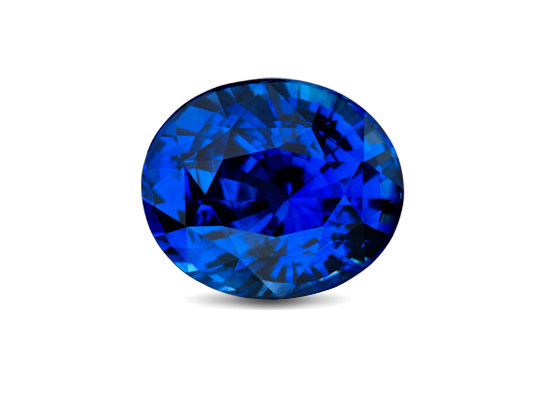
Photo Credit GIA
While sapphire is more durable than many other gemstones, for simplicity, we recommend a single, safe method for cleaning all your gemstone jewelry. A gentle solution of warm water and gentle dish detergent safely cleans sapphire jewelry. For additional details, please read our blog Cleaning Fine Gemstone Jewelry. To learn about caring for your fine jewelry, please read our blog Caring For Fine Gemstone Jewelry.
Color Characteristics and Treatments
As noted earlier, sapphires aren’t strictly blue. They also come in a variety of colors based on trace elements contained within the stone’s crystal structure. The most significant factor in a sapphire’s price is its color, and each color has its own quality considerations. The most desired sapphires have strong to vivid saturation, regardless of hue. In general, the more intense and uniform the color, the more valuable the stone.
Blue sapphires– The color range of blue sapphire is greenish blue to violetish blue. The most valuable blue sapphires are a pure velvety blue to violetish blue in medium to medium-dark tones which glow like they’re lit from within. Sapphires with these qualities command the highest prices per carat. Less valuable blue sapphires might be grayish, too light, or too dark. As with all gems, the larger, clearer and more flawless the sapphire, the more expensive it is. Natural, untreated pure blue Sapphires, ranging in color from deep navy to icy blue, are considered the most rare and valuable sapphires by gemstone experts.
In addition to color, size, clarity and treatment, a sapphire’s place of origin can make a huge impact on its value. The deep, rich blue of Kashmir sapphires, the deep blue hue of Burmese sapphires and the lively and slightly violet “cornflower” blue of Ceylon sapphires are among the most highly regarded and expensive sapphires.
Fancy Sapphires – Fancy sapphires are generally less available than blue, and some colors are scarce, especially in large sizes. Still, fancy sapphires create a rainbow of options, each with its own color range, causes of color, and market. To simplify this discussion, they’re grouped together in color categories:
- Pink and Purple Sapphires - Pink sapphires range from light red to light purple with weak to intense color saturation which fall outside the color ranges for ruby or purple sapphire. Purple sapphires always have purple as the dominant color. They range from medium to dark reddish purple to violetish purple with weak to vivid color saturation.
- Yellow to Orange Sapphires - Yellow sapphires range from light to dark greenish yellow to orangy yellow with weak to intense color saturation. The finest yellow sapphire is yellow to orangy yellow with vivid saturation. Orange sapphires range from yellowish orange to reddish orange. The finest orange sapphires are pure orange to red-orange with medium tone and vivid saturation.
- Padparadscha Sapphire - The unique and rare combination of pink and orange in one stone resembling an exotic sunset or a lotus flower makes padparadscha quite rare. Padparadscha’s mixture of pink and orange color can be hard to describe, but those who deal in them usually agree they should range from light to medium pinkish orange to orange-pink. Traditionally, it was accepted that a true padparadscha would only come from Sri Lanka. Modern discoveries in East African mines brought more acceptance of new sources. It is also now accepted that padparadscha be heat treated. Padparadschas typically have a high value; much higher than many other fancy sapphires.
- Green Sapphires - Green sapphire tends to exhibit a subtle color in contrast to the vibrant green seen in garnet or emerald. Commercial-grade sapphires may contain a less desirable visible greenish blue color. Uniformly green sapphires that are saturated in color are actually rare and prized by many collectors. Green sapphire output has improved in recent years.
- Colorless Sapphires - In its purest state, the mineral corundum, is colorless. Colorless sapphires, however, are rare and were once popular diamond imitations. They’ve staged a comeback as accent stones in recent years.
- Black Sapphires – Black sapphires range from blue-black to gray. The black color results from inclusions.
Phenomenal Sapphires – Phenomenal sapphires possess striking optical effects of color change and asterism. Color change is a distinct change of colors under different lighting conditions. Asterism, aka “star effect” is the appearance of a star in the dome of a sapphire cut as a cabochon.
- Color Change Sapphires - Under daylight equivalent light, the typical color-change sapphire ranges in color from blue to violet. Under incandescent light, it ranges from violetish purple to strongly reddish purple. Some rare color-change sapphires change from green in daylight to reddish brown in incandescent light. The strength of the stone’s color change is the most important quality factor affecting its value.
- Star sapphires - Star sapphires can be blue or any of the rainbow of fancy colors. The best and most expensive star sapphire is semi-transparent with crisp, distinct rays against a strongly saturated body color. Some star sapphire body colors are valued more highly than others. In general, the most prized color is blue. Stars are usually made up of 2, 3 or (rarely) 6 intersecting bands, resulting in 4, 6 or 12 ray stars. The reflective stars should contrast strongly against the gemstone’s body color. The quality of the star’s rays has a great effect on its value. The finest star is distinct, centered on the top of the stone, visible from a reasonable distance (about arm’s length), have elegant “movement” and look the same when viewed from all directions.
Sapphire Clarity–Blue sapphires typically have inclusions, often containing delicate intersecting needles of the mineral rutile known as silk. Those with extremely high clarity are rare, and very valuable. In general, inclusions make a stone less valuable. Price can drop substantially if the inclusions threaten the stone’s durability. On the other hand, inclusions can actually increase the value of some sapphires. Many of the most valuable Kashmir sapphires contain tiny inclusions that give them a velvety appearance. They scatter light, causing the coveted visual effect without negatively affecting the gem’s transparency.
Color zoning, areas of different color saturation within a stone, is a common sapphire characteristic. Blue sapphire often has angular zones of blue and lighter blue. To accommodate color zoning in some sapphires, cutters try to orient the concentrated color in a location that offers the best visible color in the cut stone.
Treatments - Sapphires are frequently treated to improve color or clarity. Because of the great variety of sapphire treatments, it is almost impossible to list them all. Heat treatment is common and permanent and well accepted in the trade. Less common treatments such as lattice diffusion, fracture filling and dyeing may require special care. Lattice diffusion is often used to alter and improve the color of orange, pinkish-orange, yellow, and blue sapphires. Under intense heat, beryllium or a similar element is diffused onto the surface or throughout the gemstone. In some cases, the color induced by lattice diffusion is so shallow it could be removed if the stone was chipped or had to be re-polished or re-cut. Fracture-filled and dyed sapphires can be damaged when in contact with even mildly acidic products.
Some blue star sapphires are also diffusion treated. The starting material is very low grade but the diffusion treatment creates a deep blue color and a very sharp star.
Reputable sellers, like 100 East Fine Jewelry, will disclose any treatments or enhancements that a sapphire, or any other gemstone, has undergone prior to purchase. Just to be safe, it’s a good idea for you to ask if it the gemstones are treated and by what method.
Synthetic sapphire - Synthetic sapphire is very common, with some being very convincing substitutes for the natural gem. It can be produced by a variety of methods, which makes it available at many price levels, from very affordable to very expensive. Some of the earliest examples of synthetic sapphires can be found in original pieces of art nouveau and art deco jewelry. Color change synthetic sapphire, made to imitate alexandrite, has been popular since the early 1900s. Induced inclusions can cause star effects in some synthetic sapphires. Synthetic sapphire is so durable, it’s used for watch crystals, the windows of supermarket scanners, protective covers of electronic devices and aircraft windows.
Formation, Mining and Cutting
The mineral corundum in its pure form is composed of aluminum and oxygen and requires a growth environment that’s free of silicon. However, silicon is a very common element, making natural corundum relatively uncommon. While pure corundum is colorless, most corundum contains color-causing trace elements. When the trace elements are iron and titanium, the corundum is blue sapphire. Only a few hundredths of a percent of iron and titanium can cause the color, and the more iron the corundum contains, the darker the blue. Chromium can cause the red color of ruby or the pink of pink sapphire.
Lending to sapphire’s popularity is its presence in nearly every corner of the earth. Today, approximately 20 countries around the world are known to produce ruby and sapphire. Asia is a well-known source of sapphire including Myanmar, Cambodia, Thailand, Laos, Vietnam, Sri Lanka, and Kashmir. African deposits in Kenya, Tanzania, Nigeria, Madagascar, and Ethiopia provide brilliant sapphires of every color. Australia has been a steady source of sapphires for years. The US state of Montana, along with Brazil and Colombia in South America are also sapphire sources.
By sheer volume, Australia accounts for approximately 50% of worldwide production, with Madagascar, Tanzania, Sri Lanka, Myanmar, Cambodia and Kenya accounting for about 35%. Madagascar is a relative newcomer as a major sapphire source, but its stones can have an intense blue color that rivals the finest stones from more traditional sources. Although the US state of Montana’s sapphire production and popularity is increasing, its portion of global production is very small. This ring I designed has a Montana blue sapphire as the featured center stone.

Rough sapphire’s most common crystal form is a barrel- or spindle-shaped hexagonal pyramid.
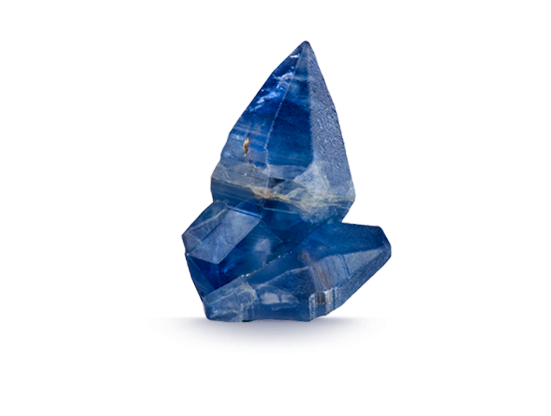
Photo Credit GIA
The shape of a rough sapphire crystal influences the cutting of the finished stone and its ultimate gemstone shape and weight. To achieve the best overall color, maintain the best proportions, and retain the most weight possible of the finished gemstone, cutters focus on factors like color zoning and inclusions to best determine how to orient the gem during cutting.
Famous Sapphires
There are many famous sapphires which have been placed in luxurious jewelry pieces over the centuries. Here are but a few.
As mentioned above, perhaps the best-known sapphire in recent years is the 12 carat oval blue sapphire first worn by Princess Diana and then given by Prince William for his engagement to Kate Middleton. The sapphire is surrounded by fourteen solitaire diamonds and set in 18K white gold.
Other famous sapphires include the Rockefeller Sapphire, a 62.02 carat rectangular step cut stone that was unearthed in Myanmar. Acquired in 1934 by financier and philanthropist John D. Rockefeller, Jr. from an Indian maharaja, the gem was recut and remounted over the years. The sapphire was first set as a brooch and later as a ring featuring two triangular diamond side stones. It sold at auction in 2001 for slightly more than $3 million.
The “Conchita Montana Sapphire Butterfly” is a brooch currently located in the Smithsonian Institute. It was a collaboration by jewelry designer Paula Crevoshay and gem dealer/gemologist Robert Kane and was donated by them to the Smithsonian’s National Gem Collection in 2007. It is set in 18 Kt yellow gold and contains 331 brilliant cut and 2 cabochon cut blue and a rainbow of fancy colored Montana-mined sapphires. I had the pleasure of seeing the “Conchita” in person, meeting Ms. Crevoshay and acquiring Montana sapphires from Mr. Kane for inclusion in some of my jewelry pieces.
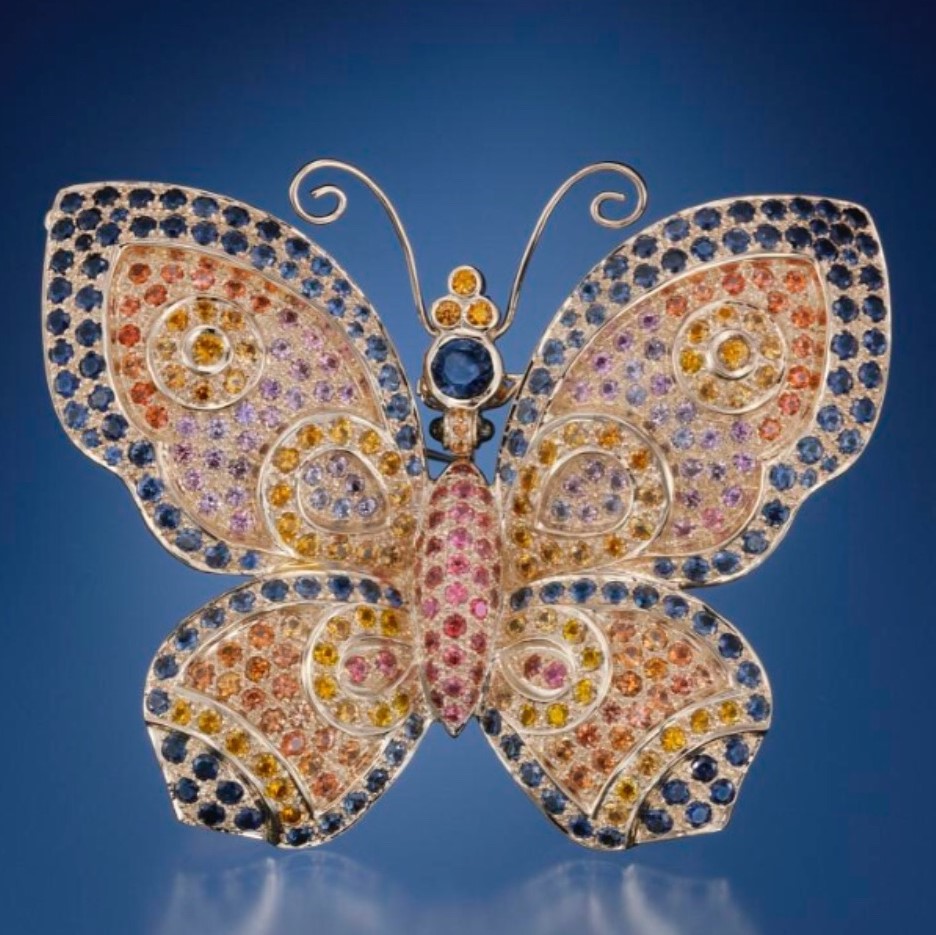
Check out the rest of our fine jewelry online.
Text courtesy of Gemological Institute of America (GIA) and American Gem Trade Association (AGTA).

